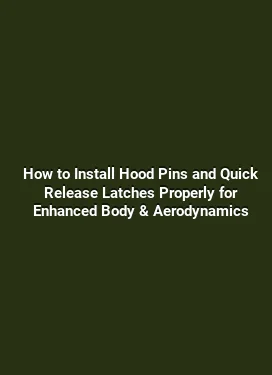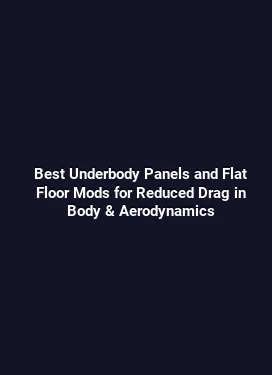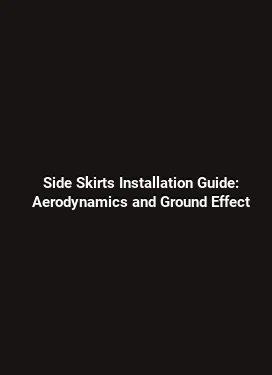Best Rear Diffuser Designs for Improved Aerodynamic Efficiency
Rear diffusers stand at the intersection of performance and efficiency, translating complex fluid dynamics into tangible on-road or track benefits. Their primary role is to manage the transition of high-speed exhaust air from the underbody, shaping wake structures and reducing pressure drag while increasing downforce where it matters most. A thoughtfully designed diffuser can enhance stability at high speeds, improve cornering grip, and contribute to a more balanced vehicle feel. This comprehensive guide delves into proven diffuser configurations, the physics behind their operation, material and manufacturing considerations, and practical steps for evaluating and selecting designs that align with specific vehicle goals.
The journey begins with understanding how a diffuser works. As air travels beneath the car, it accelerates and creates a low-pressure region that can either contribute to lift or be harnessed to generate downforce. A diffuser slows and smooths this air, encouraging a controlled expansion that recovers pressure more gradually as it exits to the rear. The result is a reduction in drag and an improvement in rear stability. The most effective designs balance the recovery of pressure with the management of turbulence, ensuring that the flow reattaches cleanly and remains coherent through a wide range of speeds and yaw angles.
Key Principles Behind Effective Rear Diffuser Performance

To select or optimize a diffuser, it helps to anchor decisions in a few core principles that have stood up to testing in real-world engineering and advanced computational analyses. First, the diffuser angle and depth must align with the underbody geometry to avoid creating separation zones that amplify drag. Second, the edge geometry—such as strakes, fences, or side fins—can direct airflow and minimize cross-flow between sections, preserving a stable suction peak behind the vehicle. Third, surface finish and transition radii influence boundary layer behavior, reducing small-scale vortices that can erode downforce and increase drag. Finally, integration with other body modifications, including spoiler geometry and underbody panels, determines how effectively the diffuser contributes to overall aerodynamic balance.
A practical way to frame diffuser effectiveness is through a set of measurable outcomes: downforce amount at a given speed, the drag coefficient under representative load cases, and the consistency of performance across a range of steering inputs and road textures. While the absolute numbers depend on vehicle geometry, the relative gains from a well-executed diffuser are typically most noticeable during high-speed straightaways and entering or exiting corners where the underbody flow plays a larger role in stability.
Common Diffuser Designs and Their Trade-offs
Diffusers come in a spectrum of configurations, each with distinct advantages and constraints. A modular approach, combining several elements, is common in performance-focused builds. The following outlines representative designs and practical considerations for each:
Flat Diffusers with Integrated Kinks

Flat diffusers exhibit a simple outline that matches a flatter underbody profile. The central benefit is ease of manufacturing and straightforward maintenance. The downside is that a completely flat diffuser can struggle to manage strong crossflow at higher yaw angles, potentially limiting peak downforce. Enhancements often involve modest curvature and discreet vertical ribs that guide air into the main channels without introducing sharp transition points that provoke separation.
When implementing a flat diffuser, it is common to pair it with underbody panels that smooth the floor plane and reduce roughness. This harmony helps preserve a coherent wake behind the diffuser, enabling more predictable stability characteristics at high speeds. A practical approach is to maintain a continuous contour from the front splitter to the diffuser, minimizing abrupt changes that disturb the boundary layer.
Tapered Diffusers with Side Fences
Tapered diffusers extend a depth gradient toward the rear, which enhances pressure recovery by gradually decelerating the accelerated air from the underbody. Side fences or vertical fins act like flow guides, suppressing lateral spreading and maintaining a tight, well-organized wake. This design is particularly effective on wider cars or those with wide track widths, where unrestrained side leakage can erode rear downforce gains.
Practical considerations include ensuring the fences are precisely aligned with the diffuser’s surface and that their height and spacing are tuned to the vehicle’s velocity range. In racing or spirited driving scenarios, it’s important to monitor for signs of flow reattachment or secondary separation near the trailing edge, which can negate the intended benefits. Materials with good stiffness-to-weight ratios and resistance to heat also help maintain performance under sustained high-speed conditions.
Vented Diffusers with Internal Baffles
Vented diffusers incorporate channels or openings that facilitate controlled exhaust air passage from the underbody to the rear. Internal baffles shape the flow, reducing swirl and smoothing the exit jet. This configuration can deliver meaningful drag reduction while preserving or enhancing downforce, especially when paired with rear skirts or slats that further manage the wake.
Key design notes include balancing vent size and spacing to avoid creating hot spots of turbulence. The diffuser should also integrate with the vehicle’s exhaust routing to prevent unwanted interference with thermal management or back-pressure effects that could impact engine performance in some layouts. In practice, a well-tuned vented diffuser contributes to a cleaner rear wake and improved overall efficiency in both highway and track scenarios.
Material Choices and Manufacturing Realities
Material selection influences weight, stiffness, durability, and the ability to maintain precise geometries under load. Common choices include lightweight composites, high-strength plastics, and cast or molded aluminum where rigidity is paramount. For racing and street vehicles where exposure to road debris and impacts is a concern, composite designs offer a favorable strength-to-weight ratio, while ensuring that the edge terms remain robust against denting or deformation.
Manufacturability also matters. Diffusers with complex internal channels may require advanced fabrication methods such as composite layups, vacuum forming, or precision machining. The industry trend leans toward modular, bolt-on diffuser assemblies that allow owners to swap between configurations without extensive modifications. This flexibility makes it easier to experiment with different geometries, test in a controlled environment, and iterate toward the final setup that best matches the vehicle’s aerodynamic profile and performance targets.
Integration with the Vehicle Fender and Underbody Architecture
A diffuser does not operate in isolation. Its effectiveness hinges on seamless integration with the underbody panels, rear bumper design, and the surrounding fender architecture. A diffuser aligned with a smooth underfloor channel reduces interference and ensures the boundary layer transitions smoothly toward the rear. Conversely, gaps or abrupt transitions between elements can create localized recirculation zones that undermine the intended performance gains.
Practical integration steps include aligning the diffuser’s leading edge with the lowest practical ride height while preserving ground clearance and avoiding scraping on uneven terrains. When possible, designers incorporate micro-extensions or small ramps on the underbody to guide air toward the diffuser and reduce flow separation at the onset of the rear wake. This holistic approach helps deliver consistent performance across a broad spectrum of driving conditions.
Testing and Validation: From Simulation to Real-World Feedback
Validation blends both computer-aided analyses and empirical testing. Computational fluid dynamics (CFD) simulations offer insights into pressure distributions, wake structures, and potential hotspots without the need for expensive wind tunnel runs. Real-world testing, including track sessions and controlled road evaluations, confirms how the diffuser behaves under load, allowing fine-tuning of angles, depths, and interface details.
A practical testing protocol starts with a baseline measurement of drag and downforce at multiple speeds. Subsequent iterations adjust diffuser depth, edge geometry, and venting patterns, with repeat tests to capture data consistency. Data logging should capture aero loads, tire temperatures, and suspension responses to ensure that aerodynamic gains do not come at the expense of mechanical performance or ride quality. The aim is to converge on a configuration that delivers stable downforce with minimal drag increase across the intended operating envelope.
Real-World Examples: Design Variations for Different Vehicle Types
Not all diffuser concepts suit every vehicle. Sports cars, compact coupes, and high-performance sedans each present unique challenges related to ground clearance, weight distribution, and engine bay layout. For example, a mid-engine track car may benefit from a deeper diffuser paired with aggressive side fins to manage a wide, flat wake, while a front-engine street car might gain more from a lighter, modular diffuser system that preserves daily drivability. In each case, the diffuser should be evaluated in the context of the entire body kit, ensuring that the overall silhouette remains coherent and that visual cues align with functional intent.
Owners and engineers often document incremental improvements such as reduced underbody turbulence, more predictable yaw response, and quieter wake interactions at highway speeds. These qualitative signs complement quantitative measurements and help validate the practical impact of a given diffuser design beyond theoretical expectations.
Maintenance, Durability, and Longevity Considerations
Maintenance practices play a meaningful role in sustaining diffuser performance. Regular inspection for cracks, delamination, or deformation, especially along edge lines and mounting points, helps preserve aerodynamic integrity. Cleaning away road debris and checking fasteners ensures that the diffuser remains securely attached and properly aligned. Materials chosen for longevity should tolerate exposure to heat, UV light, and surface exposure without significant deformation or warping over time.
Durability considerations also extend to impact resilience. Diffusers designed with flexible mounting strategies or energy-absorbing fasteners can better withstand occasional contact with curbs or rough road surfaces. While aesthetics are important, the structural integrity of the diffuser under dynamic loads is a fundamental driver of sustained aerodynamic performance and reliability across seasons and driving styles.
Practical Guidelines for Selecting a Rear Diffuser
When selecting a rear diffuser, consider the following practical steps. First, define the vehicle’s primary use case—daily driving, weekend track days, or a blend of both. Second, map the underbody constraints, including ride height, exhaust layout, and available mounting points. Third, choose a diffuser geometry that complements the existing aero elements, such as the front splitter or rear spoiler, to maintain a balanced aero profile. Fourth, prioritize ease of installation and serviceability, especially for owners who plan to upgrade components over time. Finally, plan a staged approach that allows progressive testing and refinement rather than a single, all-encompassing change.
Real-world experimentation often starts with a modular diffuser system that supports easy swaps of edge profiles, channel depths, and venting options. This approach enables a practical exploration of which variables most influence downforce and drag within the context of the vehicle’s powertrain and suspension setup. The goal is to arrive at a configuration that delivers tangible handling improvements without compromising everyday usability.
Conclusion: Crafting Aero-Driven Outcomes Through Thoughtful Design
Rear diffusers, when designed and integrated with precision, unlock meaningful gains in aerodynamic efficiency, stability, and overall vehicle dynamics. The best outcomes emerge from a holistic view that harmonizes diffuser depth, edge geometry, underbody architecture, and material choice, all tested through a disciplined process that combines simulation and real-world feedback. By focusing on the balance between drag reduction and downforce generation, builders can tailor diffuser configurations to meet specific performance targets while preserving driveability and durability across diverse conditions.






